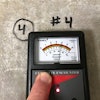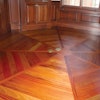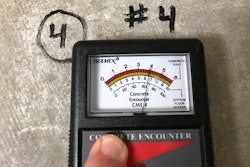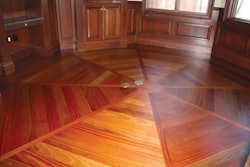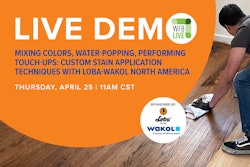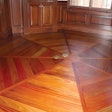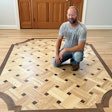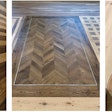Q . I have a customer who severely dented his wood floor. How do I repair it?
A . Many contractors call NWFA's tech line daily with questions about how to repair a wood floor — whether it is job-site finished, prefinished, satin or gloss finished, natural or custom stained. It can involve several boards or just one piece of flooring.
There's a big difference between a repair and a patch job. A repair will blend almost perfectly, not showing any blemishes. However, a patch job can be spotted a mile away.
When repairing a hardwood floor, time and patience with the proper tools, techniques and products will pay off in the end. It's very easy to damage pieces next to the ones that are being repaired, and if damage occurs, it makes for a long day.
For a 3/4-by-2 1/4-inch board, use a circular saw set at the proper depth (3/4 inch), making two passes approximately 3/8 inch from each side of the board (not cutting past the end joints). The third cut goes on an angle between the first two cuts, again not cutting through the side match.
Once the cuts are made, use a sharp chisel to remove the cut pieces. Clean and vacuum the groove and area around the repair, making sure all debris is removed. After these steps are complete, select a straight piece of flooring that has a similar grain pattern as the one removed. Cut the piece of flooring to the exact length to ensure a tight fit, not leaving cracks at the end joints. (This repair can also be done with a router and template.) Once the piece is cut to length, the bottom of the groove will need to be removed. This can be done by scribing the back of the board with a razor knife, then tapping the piece off with a hammer. Each end of the board can be beveled with a miter saw or by using a block plane to bevel the groove-side of the board. Always dry fit the piece before installing.
Now the piece is ready to install, using a two part epoxy. With a gun and nozzle, apply the glue in the groove and on the tongue of the boards adjoining the repair. Also, apply glue to the tongue and groove on the repair piece.
The epoxy will set up very quickly, so time is limited. The reason for using epoxy is that you can sand the repair within 10 to 15 minutes after it is properly installed. Other glues will take longer to set and will require drying overnight before the repair can be sanded.
When repairing staple- or nail-down prefinished or job-site finished floors, the repair can be done in the same manner. However, repairing a finished floor takes more time before and during the repair to avoid damage to the already finished floor.
Again, it is critical when selecting boards on a prefinished floor repair to match grain, color, sheen and appearance for best results.
When repairing a floor that has been stained and finished, it takes a great deal of experience, skill and patience to produce a successful repair.
Using an edger and fine-grit sandpaper (80-100 grit), sand the repair flat. After the repair is sanded, use a sharp scraper 1 1/2 inches wide to scrape scratches out and feather back into existing stain or finish. I call this "chasing the grain." Using the natural pattern of the grain in the wood flooring, lightly scrape and blend the area in which you are working. After all scraping is complete, clean and hand sand with 80- or 100 grit paper. Do not sand out into the finished area at this time. Then sand lightly around the repair with a finer grit of sandpaper, mainly where the finish meets the bare wood. This will smooth the finish so the stain doesn't bond to it and cause a darker halo.
Repairing glue-down products takes a different approach. The adhesive used to glue the flooring to the subfloor (whether wood or concrete) slightly glues one piece to another, therefore making the repair difficult. However, the basic technique remains the same. After making two cuts lengthwise and a third diagonally, the damaged flooring should be removed with a chisel.













